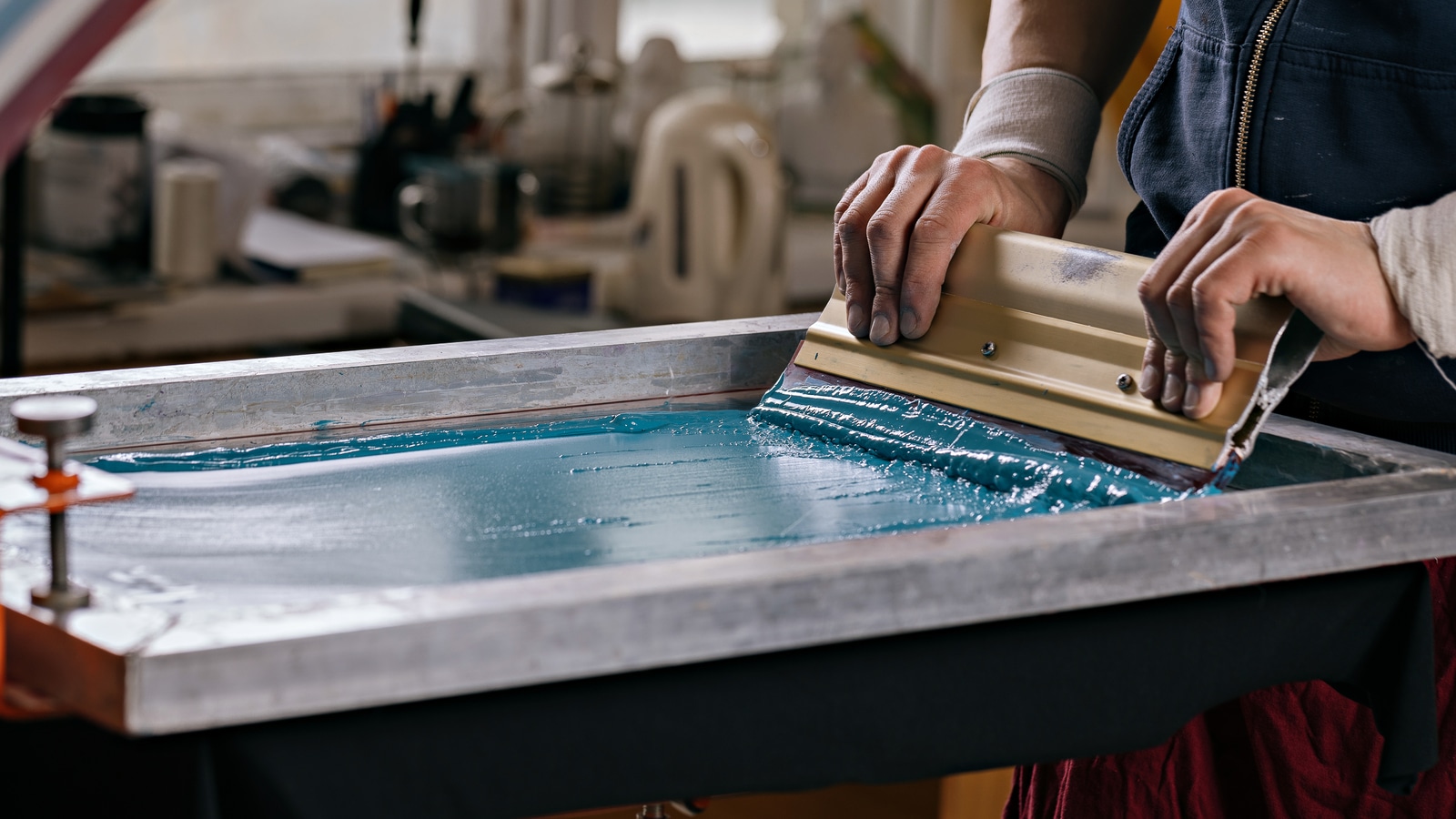Budget-Friendly T-Shirt Printing for Startups
Budget-Friendly T-Shirt Printing for Startups
Blog Article
Display Printing Uncovered: Every Little Thing You Need to Learn About T-Shirt and Garment Printing Techniques
If you've ever before questioned how those vibrant styles finish up on your preferred tee shirts, you remain in the ideal area. Screen printing is a fascinating method that incorporates art with technique, providing limitless possibilities for creative thinking. Recognizing the fundamentals, from devices to ink selections, can considerably affect your results. All set to check out the important components that make display publishing an art kind? Allow's discover the information that can raise your tasks.
The Fundamentals of Display Printing: Just How It Works
When you dive into screen printing, you'll discover it's both an art and a science. At its core, display printing involves creating a stencil, or screen, that allows ink to pass via only in particular areas.
Position the display over the material, then utilize a squeegee to push ink via the display onto the garment. Each action is important, and mastering them will elevate your screen printing abilities, changing easy garments right into distinct, expressive items.
Types of Display Printing Strategies
Once you comprehend the fundamentals of display printing, it's time to explore the various techniques that can elevate your layouts. One popular approach is typical display printing, where ink is pushed with a stenciled display. This technique is excellent for vibrant, vibrant colors. Then there's water-based ink printing, which uses a softer feeling and is eco-friendly, yet it calls for a different technique to healing.
If you're intending for great details, consider discharge printing. This strategy gets rid of color from the material, leaving a soft, vintage look. One more option is plastisol printing, understood for its resilience and brilliant colors, making it a favored for lots of brand names. Ultimately, experiment with halftone printing to create gradient results and elaborate designs. Each method has its distinct beauty, so don't wait to attempt them bent on find what fits your style best!
Crucial Equipment for Screen Printing
To accomplish sensational lead to display printing, having the appropriate devices is essential. You'll need a tough screen printing framework, which holds the mesh that moves your style onto the garment. Next, buy top notch squeegees; these are important for applying ink uniformly across the display. You'll additionally call for a good direct exposure unit to produce your displays, in addition to a washout cubicle for cleaning them after usage. A trusted warm resource, like a conveyor dryer or warm press, is vital for healing your prints to guarantee long life. Do not neglect an appropriate work area, furnished with tables and storage space for your products. Lastly, protective gear, such as gloves and masks, will maintain you risk-free from chemicals and inks. With the right tools, you'll be well on your means to creating professional-quality prints.
Selecting the Right Inks and Products
When selecting inks and products for display printing, you need to take right into account the sort of ink that works finest for your project. Assume regarding material compatibility to ensure your designs look last and excellent lengthy. Discover environmentally friendly ink choices to make your printing process much more lasting.
Sorts Of Display Inks
Selecting the right display ink is vital for achieving vivid, resilient prints that satisfy your project's demands. There are several kinds of screen inks to examine. Specialized inks, such as metal or glow-in-the-dark, can add distinct impacts to your designs.

Fabric Compatibility Considerations
Understanding fabric compatibility is vital for attaining premium screen prints, particularly because various materials react uniquely to different inks. When picking inks, think about the material kind-- cotton, polyester, or blends. For cotton, water-based inks function well, providing softness and breathability. Polyester, on the other hand, commonly calls for plastisol inks for far better adhesion and dynamic colors. If you're publishing on blends, you might require to utilize a combination of both kinds. Constantly check your inks on sample material to guarantee they adhere effectively and maintain color integrity. In addition, remember that textile weight and structure can affect the final result, so choosing the appropriate ink and material combo is important for your project's success.
Eco-Friendly Ink Options
Environment-friendly inks are ending up being a preferred choice for screen printers that desire to lessen their ecological influence while keeping high quality. When selecting inks, take into consideration water-based inks, which are less damaging and easier to cleanse up contrasted to standard solvents.
In addition, try to find inks made from sustainable sources, such as soy or vegetable-based alternatives. By selecting the appropriate inks and materials, you'll not only develop spectacular designs however also add to an extra lasting printing procedure. Make the button, and your prints will certainly reflect your dedication to the setting!
Preparing Your Layout for Display Printing

Submit Layout Needs
To ensure your design looks vibrant and sharp on textile, you'll require to pay very close attention to submit format requirements for screen printing. Begin with vector documents like AI or EPS, as they can be scaled without losing top quality. If you use raster images, go with high-resolution files, such as TIFF or PNG, ideally at 300 DPI. Prevent making use of JPEGs, as they can lose quality when resized. Make sure your style has a transparent background to protect against unwanted white edges on your prints. Maintain shade settings in mind; CMYK is common for display printing, so convert your RGB creates as necessary - screen printing kit. By complying with these guidelines, you'll set your artwork up for a successful print.
Color Separation Strategies
Shade splitting up is a crucial action in preparing your design for screen printing, and understanding it can considerably boost your print top quality. You'll require to damage your layout right into private shades, as each color needs a different display during printing. Start by identifying all the colors in your style and develop layers for each one. You can make use of software like Adobe Photoshop or Illustrator to separate and different colors successfully. Be particular to conserve each layer as a different documents, normally in a style like TIFF or PSD. This accuracy not only assures accurate next page shade representation however also simplifies the printing process. By focusing on color separation, you'll attain vibrant and professional lead to your screen-printed garments.
Resolution and Size
Attaining the finest lead to display printing starts with ensuring your design has the right resolution and dimension. Ideally, your artwork should be at least 300 DPI (dots per inch) for sharp, clear prints. Your final item could look pixelated and unprofessional. if you make use of lower resolution.
When it pertains to size, consider the dimensions of your print location. Layout your art work to match the final print dimension, preferably developing it in the real dimensions you'll be printing. By doing this, you'll stay clear of any kind of unforeseen scaling problems.
Always inspect your design in both vector and raster layouts. Vector graphics can be scaled without losing top quality, making them suitable for screen printing. Preparing properly will ensure your design looks outstanding on every garment!
Step-by-Step Screen Printing Process
Screen printing is a dynamic process that permits you to develop vibrant styles on numerous surfaces. To get started, you'll require a display, solution, and your selected ink.
Put ink onto the screen and utilize a squeegee to push the ink with the stencil onto the material. Raise the display meticulously and allow the print completely check here dry. You have actually successfully screen published your design.
Tips for Successful Screen Printing Projects
While you're diving into your screen printing tasks, keep in mind that preparation is key to success. Beginning by collecting all your materials-- inks, displays, mops, and garments. A clean workspace aids prevent undesirable errors, so tidy up before you begin.
Next, verify your artwork is high-resolution and correctly sized for your garment. Examine your display for appropriate direct exposure and clean it completely to stay clear of spots. When blending your inks, follow the maker's standards to accomplish the ideal consistency.
During printing, use also stress with your squeegee for constant results. Do not hurry; take your time to verify each print meets your standards. After printing, allow your garments dry completely before dealing with or packaging them.
Lastly, always keep an example of your help future recommendation. By doing this, you can assess your progress and enhance your methods in time. Delighted printing!

Frequently Asked Questions
How much time Does It Require To Set up a Screen Printing Work?
Establishing a screen printing job usually takes about thirty minutes to an hour. You'll prepare the displays, mix inks, and adjust journalism. The time varies based on complexity and experience, so stay organized!
Can I Publish on Different Fabric Enters Utilizing the Same Technique?
Yes, you can publish on various fabric kinds making use of the same strategy, however you'll need to change your inks and setups. Some textiles soak up ink differently, so exploring assurances the most effective outcomes for each material.
What Prevail Errors to Avoid in Display Printing?
When screen printing, stay clear of common blunders like making use of the wrong ink, disregarding proper exposure times, or skipping pre-press checks. Constantly check your arrangement and keep tidy displays to assure top quality results each time.
Just How Can I Effectively Clean and Maintain My Screen Printing Devices?
To properly tidy and keep your screen printing devices, you need to frequently wash screens with ideal solvents, examine mops for wear, and assure all tools are stored completely dry and dust-free. Consistency improves and prevents costly repair work performance.
Is Display Printing Eco-friendly Contrasted to Various Other Methods?
Display printing can be a lot more eco friendly than other techniques, specifically if Home Page you utilize water-based inks and eco-conscious products. By picking lasting materials and practices, you reduce waste and lessen your impact on the planet.
Display Printing Uncovered: Everything You Required to Know Regarding T-Shirt and Garment Printing Techniques
At its core, display printing includes producing a pattern, or screen, that permits ink to pass via just in certain locations. Position the screen over the material, after that use a squeegee to push ink via the screen onto the garment. One popular method is traditional display printing, where ink is pressed with a stenciled display.When selecting inks and materials for screen printing, you require to take into account the kind of ink that works finest for your job.
Report this page